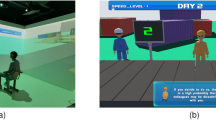Abstract
When an adaptive agent works with a human user in a collaborative task, in order to enable flexible instructions to be issued by ordinary people, it is believed that a mutual adaptation phenomenon can enable the agent to handle flexible mapping relations between the human user’s instructions and the agent’s actions. To elucidate the conditions required to induce the mutual adaptation phenomenon, we designed an appropriate experimental environment called “WAITER” (Waiter Agent Interactive Training Experimental Restaurant) and conducted two experiments in this environment. The experimental results suggest that the proposed conditions can induce the mutual adaptation phenomenon.
Similar content being viewed by others
Explore related subjects
Discover the latest articles, news and stories from top researchers in related subjects.References
Ana I, Paloma M, Ricardo A, Fernando F (2009) Learning teaching strategies in an adaptive and intelligent educational system through reinforcement learning. Appl Intell 31(1):89–106
Ide T, Inoue K (2005) Knowledge discovery from heterogeneous dynamic systems using change-point correlations. In: The SIAM international conference on data mining (SDM 05), pp 571–576
Kato R, Yokoi H, Arieta AH, Yu W, Arai T (2009) Mutual adaptation among man and machine by using f-MRI analysis. Robot Auton Syst 57(2):161–166
Kim HR, Chan PK (2008) Learning implicit user interest hierarchy for context in personalization. Appl Intell 28(2):153–166
Komagome D, Suzuki M, Ono T, Yamada S (2006) A design of robot meme cultural learning, transmitting and creation by human-robot mutual-adaptation. IPSJ SIG Notes ICS (131):7–12
Komatsu T, Utsunomiya A, Suzuki K, Ueda K, Hiraki K, Oka N (2005) Experiments toward a mutual adaptive speech interface that adopts the cognitive features humans use for communication and induces and exploits users’ adaptation. Int J Hum-Comput Interact 18(3):243–268
Komatsu T, Ohmoto Y, Ueda K, Okadome T, Kamei K, Xu Y, Sumi Y, Nishida T (2008) Definition of mutual adaptation processes based on Akaike’s information criterion. In: The 7th international workshop on social intelligence design (SID 2008), Puerto Rico
Kon H, Miyake Y (2005) An analysis and modeling of mutual synchronization process in cooperative tapping. J Hum Interface Soc 7(4):61–70
Martin GR, Jorge M, Agueda V, Marcos GG (2009) Improving accessibility with user-tailored interfaces. Appl Intell 30(1):65–71
Mohammad Y, Nishida T (2009) Robust singular spectrum transform. In: Next generation applied intelligence (the twenty second international conference on industrial, engineering & other applications of applied intelligent systems (IEA/AIE 2009)) Taiwan. LNAI, vol 5579. Springer, Berlin, pp 123–132
Ogata T, Sugano S, Tani J (2005) Open-end human-robot interaction from the dynamical systems perspective: mutual adaptation and incremental learning. Adv Robot 19(6):651–670
Thomaz AL, Breazeal C (2008) Teachable robots: Understanding human teaching behavior to build more effective robot learners. Artif Intell 172:716–737
Ueda K (2006) Mutually adaptive learning: a time factor in human-agent interaction. J JSAI (Japanese Society for Artificial Intelligence) 21(6):675–680
Ward JH Jr (1963) Hierarchical grouping to optimize an objective function. J Am Stat Assoc 58(301):236–244
Weng J, McClelland J, Pentland A, Sporns O, Stockman I, Sur M, Thelen E (2001) Autonomous mental development by robots and animals. Science 291:599–600
Xu Y, Ohmoto Y, Ueda K, Komatsu T, Okadome T, Kamei K, Okada S, Sumi Y, Nishida T (2008) Two-layered communicative protocol model in a cooperative directional guidance task. In: The 7th international workshop on social intelligence design (SID2008), Puerto Rico
Xu Y, Ueda K, Komatsu T, Okadome T, Hattori T, Sumi Y, Nishida T (2008) Woz experiments for understanding mutual adaptation. AI Soc 23(2):201–212
Yamada S, Koh K (2003) Idea: Interaction design for adaptation. J Jpn Soc Fuzzy Theory Intell Inform 15(2):185 (in Japanese)
Yamada S, Yamaguchi T (2004) Training aibo like a dog. In: The 13th international workshop on robot and human interactive communication (ROMAN-2004), Kurashiki, Japan, pp 431–436
Yamada S, Yamaguchi T (2005) Mutual adaptation of mind mappings between a human and a life-like agent. J Jpn Soc Fuzzy Theory Intell Inform 17(3):289–297
Author information
Authors and Affiliations
Corresponding author
Rights and permissions
About this article
Cite this article
Xu, Y., Ohmoto, Y., Okada, S. et al. Formation conditions of mutual adaptation in human-agent collaborative interaction. Appl Intell 36, 208–228 (2012). https://doi.org/10.1007/s10489-010-0255-y
Published:
Issue Date:
DOI: https://doi.org/10.1007/s10489-010-0255-y




